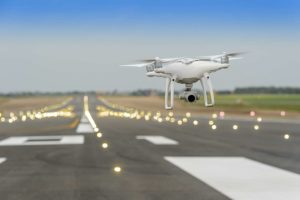If you’ve been wondering what’s happening with UTM (unmanned traffic management) you aren’t alone. That’s mostly because UTM isn’t just one policy or piece of technology, it’s a complex framework of regulations and solutions working together. Remote ID regulation and technology, which has been in development for years now, is a critical piece of that framework.
In January of 2019, the FAA began Phase I of the UTM Pilot Program (UPP.) Phase I objectives included “(1) the exchange of flight intent among operators, (2) the generation of notifications to UAS Operators regarding air and ground activities, known as UAS Volume Reservations (UVRs), and (3) the ability to share UVRs with stakeholders, including other UAS Service Suppliers (USS) and the Flight Information Management System (FIMS),” according to the FAA. This phase was completed in August of 2019.
UPP Phase 2 will test Remote ID capabilities and unmanned traffic in increasingly dense airspace, such as may be found in urban areas or around major airports. In April of 2020, the FAA chose the NY UAS Test Site at Griffis International Airport and the Virginia Tech, Mid Atlantic Aviation Partnership (MAAP) as the Phase 2 test sites: Northeast UAS Airspace Integration Research Alliance, Inc. (NUAIR), which manages the NY UAS Test Site, announced that virtual collaboration with technology partners began in April and live flights are set to begin this month.
Industry Players
A NUAIR press release lists the NY Test Site’s technology and testing partners. “Oneida County and the New York UAS Test Site have partnered with multiple local, national and international organizations to complete the work outlined in UPP Phase 2, including: Aerodyne Measure, AiRXOS, Albany County Sheriff’s Office, ANRA Technologies, AX Enterprize, Flytrex, Johns Hopkins University – Applied Physics Lab (on behalf of the FAA TCAS Program Office), NUAIR, Oneida County Sheriff’s Department, OneSky, ResilienX, Skyward, Syracuse Fire Department and TruWeather Solutions,” says the press release. This list represent drone software and services companies, international UTM providers focused on different aspects of the problem, engineering consultants, drone delivery companies, law enforcement and public safety, researchers, and more. It’s a list that indicates the complexity of UTM implementation – and the need for this kind of collaboration in developing it.
What’s Happening With UTM?
A fully functioning, fully implemented UTM system designed to handle thousands of delivery or passenger drones in the air at a time is some way off. However, considering the very recent growth of the commercial drone industry, UTM development is happening relatively quicly. Some parts of a UTM system – like the Low Altitude Authorization and Notification Capability (LAANC), which allows pilots to communicate with the FAA through an app, are already in place.
This next phase will continue to move the process forward. “Data collected from UPP Phase 2 tests will help inform a cross-agency unmanned traffic management (UTM) system implementation plan, says the NUAIR press relase.
“The collaborative work we will achieve with our industry-leading partners will help shape the commercial drone industry on a national, if not international level,” says Tony Basile, chief operations officer of NUAIR.
Miriam McNabb is the Editor-in-Chief of DRONELIFE and CEO of JobForDrones, a professional drone services marketplace, and a fascinated observer of the emerging drone industry and the regulatory environment for drones. Miriam has penned over 3,000 articles focused on the commercial drone space and is an international speaker and recognized figure in the industry. Miriam has a degree from the University of Chicago and over 20 years of experience in high tech sales and marketing for new technologies.
For drone industry consulting or writing, Email Miriam.
TWITTER:@spaldingbarker
Subscribe to DroneLife here.
https://dronelife.com/2020/09/03/whats-happening-with-utm-faa-moves-to-next-phase-of-testing/
